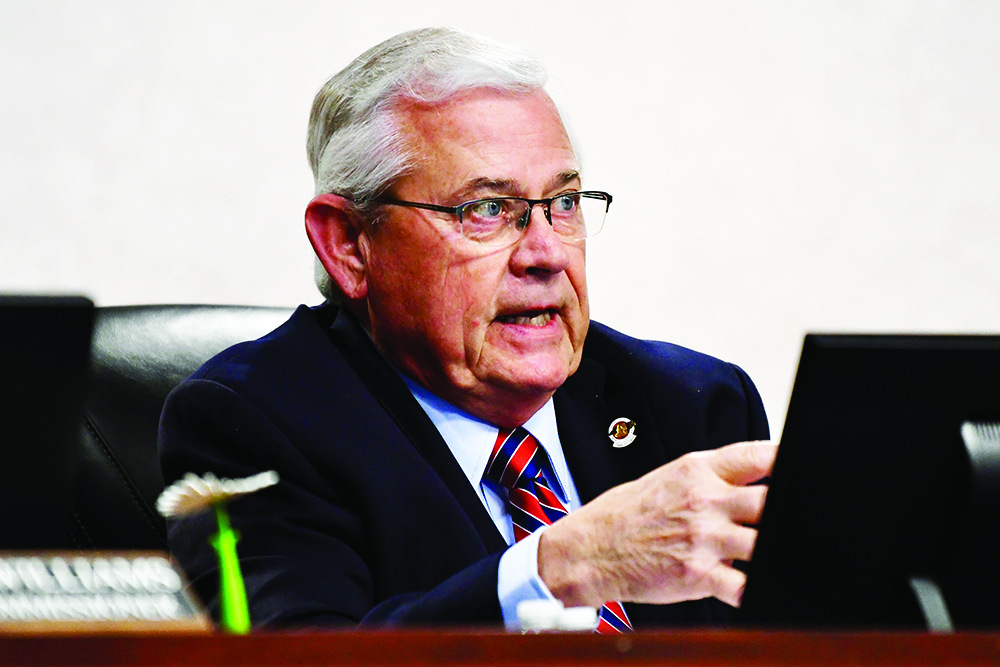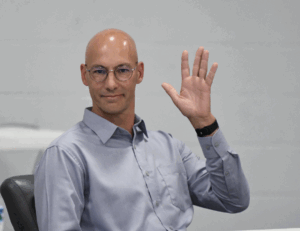
Boxing match
There was finger tapping.
There were heavy sighs.
There was inaudible mumbling.
There were eyerolls and winks.
And officials from both sides of the table, out loud, seemed to relish in what they perceived as “gotcha” moments.
But beyond the drama — and if you were in the room, it was, at times, palpable — both the Wayne County Board of Education and Board of Commissioners revealed significant information as they sparred over a question that has been debated by the two elected bodies for decades: Is Wayne County Public Schools being adequately funded by the county that houses the district?
From abhorrent academic performance numbers and a decrease in enrollment that could lead to the loss of $2 million in low-wealth funding to back-and-forths about everything from tax increases to the pending revaluation of property in Wayne County, what started off, Tuesday, as a calm repeat performance of WCPS Superintendent Dr. Marc Whichard’s Feb. 29 Maxwell Center budget reveal turned, at times, into a heated exchange between the boards’ two former chairmen and longest tenured members, Chris West and Joe Daughtery.
But ultimately, despite agreeing to continue the funding “conversation” beyond the joint meeting, the sides’ positions were fairly clear.
On the one hand, the commissioners said they are willing to listen to WCPS leaders about the needs of local schools — and even entertain increasing local funding levels — but those discussions, they said, must be accompanied by demonstrated performance improvement among students. In other words, they expect a “return on the investment” they believe the county is already making.
On the other, the school district asserts that local spending is not high enough and is, in part, responsible for the difficulty in hiring and keeping teachers and managing the upkeep of facilities.
•
Back at the Maxwell Center, albeit in a much smaller room, Whichard began the meeting with a repeat of the presentation he delivered Feb. 29 — down to the last slide.
He pointed to a comparison of Wayne to other school districts in the region to illustrate what he believes is a not-good-enough per pupil spending level. And while he conceded that several of those on the list were in coastal communities that had beach attractions that provide extra funding opportunities, he noted that Jones County, which he characterized as most similar to Wayne, spent $1,708 per student to Wayne’s $1,215 — a factor, he said, that significantly impacts the services WCPS is able to provide to its students.
Whichard also talked about the local childhood poverty rate — 22 percent — which, according to the data he presented, was eight points higher than the state average.
He admitted he was not OK with WCPS’ recent “low-performing district designation,” but assured county leaders he was confident it won’t happen again.
Whichard also, again, took a swipe at two of the county’s charter schools — Dillard Academy and Wayne Preparatory Academy — both of which, he said, have lower performance scores than WCPS.
Yet, the county taxpayers “are paying for that, too.”
The superintendent laid out many of the district’s funding needs — from capital projects, like roofs at several schools and what he said were much-need parking lot repairs to improvements at athletic facilities and a new waste management truck.
And he also pointed out that recent increases in support at the state level for teachers and school personnel as a result of legislative efforts in Raleigh, while welcome, also come with more costs to the district — that salary increases and corresponding benefit hikes also must become a part of WCPS’ spending plan.
The bottom line?
The district’s ask this coming year — $24,219,880 as well as an additional $5,150,000 for capital projects — is, he said, a necessity not a luxury.
“I know resources are tight,” Whichard said after acknowledging that WCPS’ expenses have increased exponentially over the last few years because inflation has “cleaned the district’s clock.”
But he assured the commissioners that should the county make such an investment, they would see a “significant return.”
•
Daughtery, by far the most outspoken commissioner in the room, said there was another option — for WCPS to cut expenses.
“This side of the room does not have a money tree that we can shake,” he said.
And of the ways to increase revenue, the most obvious being a property tax increase, the board’s longest tenured member said the district’s ask amounts to a $4 million increase in expenditures and a $2.5 million increase in capital funds, which, if translated into a tax increase, would mean about a 7-cent hike — not insignificant for county taxpayers, he added.
That is when the back-and-forth with West began.
“I heard you say you don’t have a money tree. Nobody does, I don’t think. I wish I had one,” West said. “But is that the only place … you’ve got to get money from is a property tax increase?”
And then, he attempted to answer his own question, asking Daughtery about the pending revaluation the county has planned for this year — if that couldn’t raise some additional funds.
“How much revenue is that going to bring?” he said.
But Daughtery snapped back, insisting that a revaluation itself would not necessarily result in higher tax bills — that there are procedures and requirements that must be taken into consideration and that a tax increase would ultimately have to be voted on by the board.
“So, what you’re saying is great news to my ear because when I go through a revaluation next year, my property taxes aren’t going to increase,” West said.
“No. I did not say that,” Daughtery replied. “I said I’ve got to tell you what your property tax rate would be to be neutral. In most cases, yes. In most cases, during revaluation, there is an adjustment. … But I didn’t say it was going to be approved by this board.”
Whichard jumped in — interjecting that the county’s property tax rates are among the lowest in the area, and that low tax rate hurts WCPS when the state calculates its share of funding.
Not charging a higher property tax rate, he said, “leaves money on the table,” which the N.C. Department of Public Instruction takes into consideration when determining the county schools’ allotment.
But Daughtery, who said he was “proud” that Wayne County had a low tax rate, said that several years ago, when commissioners voted to decrease taxes, it was done along with legislative leadership in Raleigh to get an exemption for the county — that the tax reduction would not negatively impact the district’s low-wealth funding as long at WCPS’ enrollment did not dip below 17,000 students.
And since then, as more and more families flee local public schools in favor of privates and emerging charters, “we are close to losing our low-wealth funding,” the commissioner said.
But the debate did not stop there.
Commissioners also asked about federal COVID funds (known as ESSR) for which, in the latest round, WCPS received $24 million.
Whichard explained that those funds were encumbered and could only be used for certain school projects — like, for instance, improvements to HVAC systems.
“(ESSR funding) was a blessing,” he said. “Those were one-time dollars that really helped you out.”
The money, he added, gave the district an opportunity to complete numerous projects it “couldn’t have afforded otherwise,” but it will soon be gone.
“We are trying to get all of our projects finished,” Whichard said, adding that WCPS did not intend to have to “send back” any of the federal funds.
•
As part of what he has said, several times publicly, was one of his strategies, Whichard attempted to show commissioners how the district was trying to cut costs — to tell the story of a school system that was being good stewards of the money the county has provided.
So, he talked about the recently approved facilities consolidation plan — one that will see, among other measures, students at Edgewood Community Developmental School moved to the Eastern Wayne High School campus.
The savings he believes will be realized from that plan — $750,000 annually — exemplifies his commitment to giving the county the best bang for its buck.
“We have got to do better,” Whichard said. “And we have got to do better faster.”
But Daughtery, who has been a commissioner for more than a decade, said he has heard the same claims before — that more money would keep teachers and improve the quality of the district’s then-six low-performing schools.
“I went to the mat, and we were able to get the 1-percent increase (in teacher stipends),” he said, adding that since then, the number of low-performing schools in WCPS has more than doubled. “How can I ask again? I think you all have to accept that it is not only the money that is affecting these teachers. Money is not the only factor in student performance and teacher (retention).”
But Whichard cited, again, that the county’s level of local funding is ranked in the bottom half of the state — a number that several commissioners disputed, saying that it did not take into account “extras” that the county has funded over the years, including technology, school resource officers and other items that reflect millions in additional spending.
“I have a real problem with the numbers you are using,” Daughtery said.
And that is another problem between the boards — that both have their own set of data they believe tells the “real” story.
But the bottom line, Whichard said, is that if the county wants to attract and keep good teachers in what is a well-documented shortage of available professionals, it is going to have to sweeten the deal.
“We have to be more attractive,” he said. “All I’m asking for is what can we do to compete? I am not saying that we are perfect. … The point is that we have got to do something locally to move the needle.”
Whichard said that the discussions about funding levels was not meant to embarrass the commissioners, but was simply an opportunity to provide a real-time look at the stats and the expenses the district is facing and what it will really take to make the improvements the district needs.
“I want to have as many arrows in my quiver as possible,” he said.
But Daugherty said moving forward, the district and the commissioners must have complete and accurate numbers to look at and a solid plan for improvement with measurable metrics.
“We have some serious issues with regard to public education in Wayne County and we have got to find some solutions,” he said. “If that is increasing funding, it has to be tied to performance. Once we move the needle, then we provide more funds.”
•
One thing, Commission Chairman Chris Gurley said, was clear — and it is something that he and other county leaders are hearing loud and clear from their constituents.
And getting there, he added, will require exchanges that might get heated at times, but that should be centered on that goal.
“We have got to work together,” he said. “All of us have got egos that we have got to get over and do the right thing.”
Gurley added that he has had discussions with BOE Chairman Craig Foucht about the next steps forward and that he and other commission members are intent on continuing those talks.
Improving teacher retention is one of those topics, he added.
“There are some teachers who need more money and some to whom we could never pay enough … because of what they do for our children,” he said, adding that there are others who need to “move on down the street.”
But the bottom line, he said, is that everyone’s goal is make the county schools better for the students who attend them — a mission Gurley said he has been told Whichard shares.
“(I have been told) that you are taking care of business,” he said.
Gurley added that Whichard is the new guy who inherited a mess, adding that the district did not get into this condition overnight and that the fix will not be overnight either.
Whichard said that decisions like the consolidation plan, and other cost-cutting measures and temporary fixes like the online teachers for some Wayne County classes, are tough for some community members to understand, but necessary to get the district back on track.
And while they didn’t want to dwell on it, the commissioners also discussed the impact the announcement of the changes on Seymour Johnson Air Force Base will have on the future of the schools — including decreased enrollment should airmen and their families leave Wayne County that could cost WCPS $2 million in low-wealth funds.
Whichard said the particulars are not known yet, but that the loss would have a significant impact.
But his hope, he said, is that whatever the challenges, the county’s leaders could find some common ground to meet them as a unified force.
Many in the room, ending the meeting on a conciliatory note, seemed to be in agreement — with Foucht saying he, the board, the WCPS leadership team, and staff are committed to a significant improvement plan that is “measurable, achievable, and challenging.”
“I think we owe it to the citizens of this county as taxpayers to perform better than what we have been performing,” he said. “If we don’t challenge ourselves to be better, we won’t be better.”
And Gurley said that, being better, should be everyone’s focus.
“I think both boards’ No. 1 priority is to remove our school system from low-performing and bring them up — bring our graduation rate up, you know, higher than what it is. That’s our No. 1 priority and we as local leaders … our community, that’s what they expect,” he said. “We’ve got to work together.”

A loaded discussion

Fighting for their lives

Goldsboro loses a giant

“I’m a flippin’ hurricane!”
Public Notices — Dec. 21, 2025

Belting it out

Legendary

Final Four!


